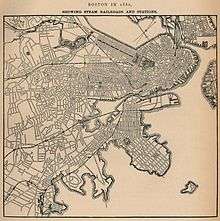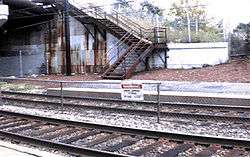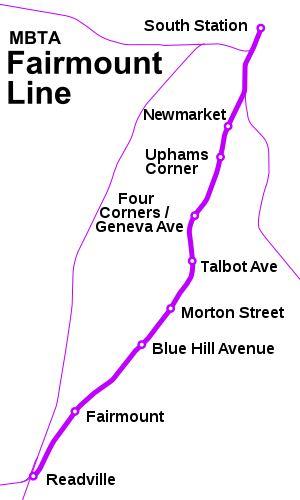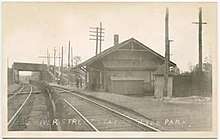Fairmount Line
The Fairmount Line or Dorchester Branch is a line of the MBTA Commuter Rail system in Boston, Massachusetts, USA. Except for a short portion in Milton, it lies entirely within Boston, running southwest from South Station through the neighborhoods of Dorchester, Mattapan and Hyde Park. Weekend service began on November 29, 2014. Most trains reverse direction at the south end at Readville, but some Franklin Line trains use the Fairmount Line rather than the Northeast Corridor. On October 21, 2019, some Fairmount Line trains were extended over the Franklin Line to Foxboro as part of the Foxboro Line.
| Fairmount Line | ||||||||||||||||||||||||||||||||||||||||||||||||||||||||||||||||||||||||||||||||||||||||||||||||||||||||||||||||||||||||||||||||||||||||||||||||||||||||||||||||||||||||||||||||
|---|---|---|---|---|---|---|---|---|---|---|---|---|---|---|---|---|---|---|---|---|---|---|---|---|---|---|---|---|---|---|---|---|---|---|---|---|---|---|---|---|---|---|---|---|---|---|---|---|---|---|---|---|---|---|---|---|---|---|---|---|---|---|---|---|---|---|---|---|---|---|---|---|---|---|---|---|---|---|---|---|---|---|---|---|---|---|---|---|---|---|---|---|---|---|---|---|---|---|---|---|---|---|---|---|---|---|---|---|---|---|---|---|---|---|---|---|---|---|---|---|---|---|---|---|---|---|---|---|---|---|---|---|---|---|---|---|---|---|---|---|---|---|---|---|---|---|---|---|---|---|---|---|---|---|---|---|---|---|---|---|---|---|---|---|---|---|---|---|---|---|---|---|---|---|---|---|
An inbound train at Talbot Avenue station in July 2019 | ||||||||||||||||||||||||||||||||||||||||||||||||||||||||||||||||||||||||||||||||||||||||||||||||||||||||||||||||||||||||||||||||||||||||||||||||||||||||||||||||||||||||||||||||
| Overview | ||||||||||||||||||||||||||||||||||||||||||||||||||||||||||||||||||||||||||||||||||||||||||||||||||||||||||||||||||||||||||||||||||||||||||||||||||||||||||||||||||||||||||||||||
| Type | Commuter rail line | |||||||||||||||||||||||||||||||||||||||||||||||||||||||||||||||||||||||||||||||||||||||||||||||||||||||||||||||||||||||||||||||||||||||||||||||||||||||||||||||||||||||||||||||
| System | MBTA Commuter Rail | |||||||||||||||||||||||||||||||||||||||||||||||||||||||||||||||||||||||||||||||||||||||||||||||||||||||||||||||||||||||||||||||||||||||||||||||||||||||||||||||||||||||||||||||
| Status | Operating | |||||||||||||||||||||||||||||||||||||||||||||||||||||||||||||||||||||||||||||||||||||||||||||||||||||||||||||||||||||||||||||||||||||||||||||||||||||||||||||||||||||||||||||||
| Locale | Eastern Massachusetts | |||||||||||||||||||||||||||||||||||||||||||||||||||||||||||||||||||||||||||||||||||||||||||||||||||||||||||||||||||||||||||||||||||||||||||||||||||||||||||||||||||||||||||||||
| Termini | South Station Readville | |||||||||||||||||||||||||||||||||||||||||||||||||||||||||||||||||||||||||||||||||||||||||||||||||||||||||||||||||||||||||||||||||||||||||||||||||||||||||||||||||||||||||||||||
| Stations | 9 active | |||||||||||||||||||||||||||||||||||||||||||||||||||||||||||||||||||||||||||||||||||||||||||||||||||||||||||||||||||||||||||||||||||||||||||||||||||||||||||||||||||||||||||||||
| Daily ridership | 2,652 (2018)[1] | |||||||||||||||||||||||||||||||||||||||||||||||||||||||||||||||||||||||||||||||||||||||||||||||||||||||||||||||||||||||||||||||||||||||||||||||||||||||||||||||||||||||||||||||
| Operation | ||||||||||||||||||||||||||||||||||||||||||||||||||||||||||||||||||||||||||||||||||||||||||||||||||||||||||||||||||||||||||||||||||||||||||||||||||||||||||||||||||||||||||||||||
| Owner | Massachusetts Bay Transportation Authority | |||||||||||||||||||||||||||||||||||||||||||||||||||||||||||||||||||||||||||||||||||||||||||||||||||||||||||||||||||||||||||||||||||||||||||||||||||||||||||||||||||||||||||||||
| Operator(s) | Keolis North America | |||||||||||||||||||||||||||||||||||||||||||||||||||||||||||||||||||||||||||||||||||||||||||||||||||||||||||||||||||||||||||||||||||||||||||||||||||||||||||||||||||||||||||||||
| Character | Elevated and surface-level | |||||||||||||||||||||||||||||||||||||||||||||||||||||||||||||||||||||||||||||||||||||||||||||||||||||||||||||||||||||||||||||||||||||||||||||||||||||||||||||||||||||||||||||||
| Technical | ||||||||||||||||||||||||||||||||||||||||||||||||||||||||||||||||||||||||||||||||||||||||||||||||||||||||||||||||||||||||||||||||||||||||||||||||||||||||||||||||||||||||||||||||
| Line length | 9.2 mi (14.8 km) | |||||||||||||||||||||||||||||||||||||||||||||||||||||||||||||||||||||||||||||||||||||||||||||||||||||||||||||||||||||||||||||||||||||||||||||||||||||||||||||||||||||||||||||||
| Track gauge | 4 ft 8 1⁄2 in (1,435 mm) | |||||||||||||||||||||||||||||||||||||||||||||||||||||||||||||||||||||||||||||||||||||||||||||||||||||||||||||||||||||||||||||||||||||||||||||||||||||||||||||||||||||||||||||||
| ||||||||||||||||||||||||||||||||||||||||||||||||||||||||||||||||||||||||||||||||||||||||||||||||||||||||||||||||||||||||||||||||||||||||||||||||||||||||||||||||||||||||||||||||
From the 1980s until 2012, the Fairmount Line had only five stations: three plus the two termini (South Station and Readville); however, three more stations were added to the line between 2012 and 2013. The first of these, Talbot Avenue, opened on November 12, 2012, followed by Newmarket and Four Corners/Geneva on July 1, 2013. Due to neighborhood opposition over its design and location, another planned station, Blue Hill Avenue, did not open until February 25, 2019. All stations on the line are fully accessible.
The corridor currently serves mostly low-income and working-class communities.[2] Despite frequent cancellations, a June 2016 count showed that ridership had nearly tripled from 2012.[3] While the line is still the least-used on the MBTA Commuter Rail system, it has seen significant recent growth from 789 daily riders as of 2012 to 2,652 daily riders by a 2018 count.[1]
History
Former service

The line was built as an entrance to Boston for the Norfolk County Railroad and its successors, which originally had to rely on a connection via the Boston and Providence Railroad (B&P) from Dedham. The new line, built in 1855, split from the old one at Islington and ran northeast, crossing the Boston and Providence Railroad at Readville. It continued on through Hyde Park and Dorchester before crossing the Old Colony Railroad at South Bay Junction. The line continued into South Boston and made a sweeping curve along a trestle west to downtown Boston and a terminal at Dewey Square.
After several failed reorganizations, the line became part of the New York and New England Railroad (NY&NE) in 1873 and the New England Railroad in 1895. The New England was leased to the New York, New Haven and Hartford Railroad (NYNH&H) in 1898 and became their Midland Division. The line was operationally split at the junction with the Boston and Providence (also leased by the NYNH&H) at Readville, with many trains using the Midland from the southwest switching to the B&P, and some on the B&P from the south switching to the Midland.
In 1899, the new South Station union station opened, and a new set of tracks was built for the Midland on the west side of the Old Colony Railroad mainline, also part of the NYNH&H. The old South Boston station (located on West 1st Street between A and B Streets) was abandoned, being north of the junction with the new alignment, and the old terminal was no longer used, with the last bit of the old line (over Fort Point Channel) removed, and the rest used for freight only. South Boston was however served by the station that had been built for the Old Colony, now between the Old Colony and Midland tracks.
Under New Haven Railroad control, most intercity and some commuter trains from the former NY&NE (now the Franklin Line) switched onto the Northeast Corridor mainline (former B&P) at Readville, with Midland Branch service largely limited to local trains. Passenger service last ran on the Midland north of Readville in 1944 after a long period of declining ridership, though the line continued to be used for freight service to South Boston.
Restoration of passenger service

The MBTA had bought the Franklin Line tracks south of Readville from Penn Central in 1973. In 1976, the MBTA bought the Midland line from Readville to Southampton Street.[4] On December 7, 1976, the agency awarded a $3.7 million contract to modernized the line for use as a bypass while the Northeast Corridor was closed during the Southwest Corridor project. Three of the old stations - Fairmount, Morton Street and Uphams Corner - were rebuilt with bare asphalt platforms and opened for local commuter service.[5] On November 3, 1979, all trains on the Franklin and Providence/Stoughton Lines, as well as Amtrak intercity service, were rerouted via the Midland.[4] The restored service on the line was not intended to be permanent; however, it became locally popular.[6] Uphams Corner and Morton Street stations closed on January 30, 1981, as part of system-wide cuts that included the closure of the Woburn Branch.[4]
On October 5, 1987, the new Southwest Corridor opened to commuter service; most Franklin Line and Attleboro/Stoughton Line service was rerouted through it. The MBTA began operating the Fairmount Shuttle (later known as the Fairmount Line) between South Station and Fairmount on the old Midland tracks as a response to community demand. The stops at Morton Street and Uphams Corner were reopened. The shuttle was extended to Readville on November 30, 1987.[4] The route - sometimes called the Dorchester Branch by the MBTA - is used by some rush-hour Franklin Line trains to reduce load on the three-track Southwest Corridor and supplement the shuttle service. An MBTA study released in 2010 indicated that the most workable routing options for full-time service to Foxboro would involve extending some or all Fairmount Line trips to Foxboro over part of the Franklin Line.[7]
Some Providence/Stoughton Line trips used the Fairmount Line tracks until around 2004, when they were rerouted to the mainline to avoid passing through CSX's Readville 1-Yard. During disruptions on the Northeast Corridor north of Readville, Franklin and Providence service is sometimes diverted over the Fairmount Line.[8]
Improvement project

The Commonwealth of Massachusetts agreed in 2005 to make improvements on the Fairmount Line part of its legally binding commitment to mitigate increased air pollution from the Big Dig. To comply with the State Implementation Plan filed with the federal Environmental Protection Agency, the improvements were required to have been completed by December 31, 2011. As an interim deadline, the Massachusetts Executive Office of Transportation was required to "complete final design, apply for all necessary permits and grants, file any required legislation, and initiate all public and private land acquisition" by December 1, 2009.[9]
The existing Uphams Corner and Morton Street stations were rebuilt, featuring high-level train platforms for easy boarding, canopies, access ramps, electronic message boards, and pedestrian-friendly walkways. Since the completion of the project, all stations on the line are compliant with the Americans with Disabilities Act and be wheelchair-accessible.[10] Four new stations were constructed at Four Corners/Geneva, Talbot Avenue, Blue Hill Avenue, and Newmarket. Additionally, six bridges have been reconstructed, a new interlocking was added, and the signal system has been rebuilt.[10]
The MBTA has allocated $37 million to the project and $39 million has been allocated from the Commonwealth from the Emergency Needs Bond Bill of 2007.[9] The total cost of the project is estimated at $79.4 million.[11] The addition of new stations and the upgrades to the existing infrastructure are projected to divert 220 daily trips from automobiles to transit,[12] and increase daily weekday ridership on the line from around 2,800 to 7,300 one-way trips.[13] A $22.9 million reconstruction of the Massachusetts Avenue, Quincy Street, and Columbia Road bridges began in January 2007.[14]
The plan adopted by the MBTA is based on the Indigo Line plan advanced by community activists, which was intended to make the characteristics of the line more like rapid transit than commuter rail, with increased frequency and number of stops. However, in its initial proposal the MBTA did not plan to increase service frequency to match rapid transit lines, nor to install pre-pay fare systems. The Indigo Line plan also called for the use of diesel multiple unit (DMU) cars for faster acceleration and deceleration, which was considered by the MBTA but not implemented initially because of lack of funding. The proposed 2014 state budget included some funds to purchase DMU railcars and the state issued a request for proposals to purchase 30 DMUs, with deliveries starting in 2018,[15] but the plan was canceled in 2016.[16]
The first new station to be completed, Talbot Ave, opened on November 12, 2012.[17] Newmarket and Four Corners/Geneva opened on July 1, 2013.[18] Five new round trips were also added, and Fairmount station was changed to fare zone 1A (to reduce fares to the same as rapid transit) for two years as a pilot program.[19] Ribbon-cutting ceremonies were held at Newmarket, Four Corners/Geneva Ave, and Talbot Ave on July 17, 2013.[20]
The location and design of Blue Hill Avenue has been more controversial. A public meeting held in April 2014 showed mixed local opinions about the stations, with some nearby residents feeling that the stop was imposed on the neighborhood by the MBTA without sufficient public input.[21] At a later meeting, the MBTA presented a plan under which construction would begin in September 2015 for a June 2017 opening.[22] On October 16, 2014, the MBTA announced that construction of Blue Hill Avenue station will resume, with 100 percent design expected in spring 2015 and construction to start that November for a December 2017 opening. The MBTA also then announced that hourly weekend service would begin on November 29, 2014 - the first weekend service on the line since passenger service was reintroduced in 1979.[15] In October 2016, the station entered the bidding phase with construction planned for 2017 and a station opening in 2019.[23] Construction of the station began on June 3, 2017. To accommodate construction work at the station site, all weekend Fairmount Line trains in both directions were cut back to Morton Street, with bus shuttles between Morton Street, Fairmount, and Readville, and late-night outbound Fairmount Line service on weekdays was completely replaced with busses.[24][25] The station opened on February 25, 2019.[26]
A pedestrian bridge was built between Ceylon and Bird Streets in the 1980s (during the initial restoration of the line) to prevent pedestrians from dangerously crossing the tracks. Although well-trafficked, the bridge deteriorated due to lack of maintenance and became unsafe; lighting was not replaced after persistent vandalism, and robberies were common. Residents field a petition with the MBTA in 2010, but no actions were taken until the MBTA closed the bridge outright in March 2014 due to its condition.[27][28] As of April 2014 no plan is in place to repair or replace the bridge, which may be difficult and expensive as the Americans with Disabilities Act of 1990 requires handicapped-accessible ramps. The City of Boston and the MBTA each claim the other is responsible for maintaining and funding the bridge.[29] The bridge was later removed entirely.
The line was shut down on weekends in November and December 2017 for the installation of Positive Train Control equipment in order to meet a 2020 federal deadline.[30]
Foxboro service
A 2010 study on the potential addition of regular commuter service to the limited-service station at Foxboro included the possibility of extending Fairmount Line trains to Foxboro.[31] In August 2017, the MBTA Fiscal Control Board approved an 11-month pilot program to test commuter rail service to Foxboro, with service planned to begin sometime in late 2018 or early 2019, although Fairmount Line advocates warned it might reduce service quality to existing Fairmount Line stations.[32] Service to Foxboro - a combination of extended Fairmount Line trains and rerouted Franklin Line trains - began on October 21, 2019.[4] Some local advocates have criticized the extension, saying it would degrade service at existing stops for the benefit of wealthier suburban commuters, while others believe it may make higher-frequency service possible.[33]
2020-21 pilot
In January 2020, the MBTA Fiscal Management and Control Board voted to add four weekday round trips as a one-year pilot program, originally planned to begin on May 18, 2020, but later postponed due to the COVID-19 pandemic. The $1.1 million pilot will increase service to 24 round trips on weekdays.[34] CharlieCard readers were be placed at stations to provide a proof-of-payment ticket that allows a transfer to subway or bus.[34] The expanded service began on June 22, 2020.[35]
Station listing
Current stations
| Fare zone | Location | Mile (km)[36] | Station | Connections and notes |
|---|---|---|---|---|
| 1A | Boston | 0.0 (0.0) | ||
| 2.0 (3.2) | ||||
| 2.4 (3.9) | ||||
| 3.4 (5.5) | ||||
| 4.5 (7.2) | ||||
| 5.3 (8.5) | ||||
| 6.0 (9.7) | ||||
| 7.9 (12.7) | ||||
| 2 | 9.2 (14.8) |
Historical and current stations

| Mile (km)[36][37] | Station | Notes |
|---|---|---|
| 0.0 (0.0) | South Station | |
| 0.7 (1.1) | South Boston | Formerly located at West 4th Street |
| 2.0 (3.2) | Newmarket | Opened 2013 |
| 2.2 (3.5) | Cottage Street[6] | |
| 2.4 (3.9) | Uphams Corner | Formerly Stoughton Street (until 1880s), then Dudley Street (until 1921) |
| 2.8 (4.5) | Bird Street | |
| 3.4 (5.5) | Four Corners/Geneva | Opened 2013 |
| 3.6 (5.8) | Mount Bowdoin | |
| 4.1 (6.6) | Harvard Street | |
| 4.5 (7.2) | Talbot Avenue | Opened 2012 |
| 4.7 (7.6) | Dorchester | Formerly located at Woodrow Avenue |
| 5.3 (8.5) | Morton Street | Originally Forest Avenue (pre-1944) |
| 6.0 (9.7) | Blue Hill Avenue | Originally Mattapan (pre-1944) |
| 6.5 (10.5) | Rugby | Formerly located at Greenfield Road |
| 6.8 (10.9) | River Street | |
| 7.9 (12.7) | Fairmount | Sometimes (pre-1944) known as Hyde Park |
| 8.3 (13.4) | Glenwood | Formerly located at Glenwood Avenue |
| 9.2 (14.8) | Readville | |
| Currently operating station | ||
References
- "Commuter Rail Ridership Counts" (PDF). Massachusetts Bay Transportation Authority. January 28, 2019.
- Fairmount/Indigo Line Coalition Comments on Fare Increase, 6/29/2006
- Nelson\Nygaard Consulting Associates (April 2017). "Increasing Ridership on the Fairmount Line: Final Report" (PDF). The Boston Foundation. p. 12.
- Belcher, Jonathan. "Changes to Transit Service in the MBTA district" (PDF). NETransit.
- A Chronicle of the Boston Transit System. Massachusetts Bay Transportation Authority. 1981. p. 12 – via Internet Archive.
- KKO and Associates (October 15, 2001). Fairmount Line Feasibility Study: Task One:Assessment of Existing Conditions (Draft). Massachusetts Bay Transportation Authority.
- Jacobs Engineering Group; Central Transportation Planning Staff; Gailbraith, Anne S. (September 1, 2010). "Foxborough Commuter Rail Feasibility Study" (PDF). Massachusetts Bay Transportation Authority. Retrieved January 8, 2014.
- "Electrical fire delays MBTA Commuter Rail, Amtrak: Fire at Forest Hills station goes to 2-alarms". WCVB. April 4, 2015. Retrieved April 7, 2015.
Passengers using the Franklin and Providence lines to get into Boston are being diverted to the Fairmount line to get into the city, according to commuter rail officials.
- "State Implementation Plan – Transit Commitments: Status Report" (PDF). Massachusetts Executive Office of Transportation. July 2, 2007. Archived from the original (PDF) on February 13, 2012. Retrieved August 3, 2011.
- "Fairmount Line Improvements". Massachusetts Bay Transportation Authority. Retrieved August 3, 2011.
- Draft 2008-2013 MBTA Capital Improvement Plan, p. 128.
- 2004 MBTA Program for Mass Transportation, Appendix, Table C-15.
- Mac Daniel, "T To Begin Upgrade of Fairmount Rail Corridor," The Boston Globe, April 14, 2005
- "Fairmount Bridge Project Underway" (Press release). Massachusetts Bay Transportation Authority. January 7, 2007.
- "Governor Patrick Announces Fairmount Line Service Upgrades". MassDOT Blog (Press release). Massachusetts Department of Transportation. October 16, 2014. Retrieved October 17, 2014.
- Pattison-Gordon, Jule (February 10, 2016). "Fairmount line setback: No DMUs says MBTA". Bay State Banner. Retrieved November 20, 2019.
- Rocheleau, Matt (November 12, 2012). "MBTA opens new commuter rail station at Talbot Avenue in Dorchester on Fairmount Line". Boston Globe. Retrieved November 12, 2012.
- Rocheleau, Matt (June 25, 2013). "Commuter rail gives Fairmount a boost". Boston Globe. Retrieved July 5, 2013.
- Rocheleau, Matt (June 24, 2013). "Fairmount commuter rail line to see service boost, some cheaper fares". Boston Globe. Retrieved June 24, 2013.
- "Patrick Administration Opens Three New Commuter Rail Stations". Massachusetts Bay Transportation Authority. July 17, 2013. Retrieved July 17, 2013.
- "Everything Was Quiet & Business-like at Mattapan Transpo Meeting, And Then ..." Here and Sphere. April 11, 2014. Retrieved April 13, 2014.
- "Blue Hill Ave Station Design Meeting" (PDF). Massachusetts Bay Transportation Authority. September 15, 2014. Retrieved October 2, 2014.
- Garrett, Brianne (October 13, 2016). "Mattapan residents get T station update; officials get positive nods, hear concerns". Dorchester Reporter. Retrieved October 14, 2016.
- "Current Service Alerts, Advisories, Delays, and Outages". www.mbta.com. Massachusetts Bay Transportation Authority. August 5, 2017. Archived from the original on August 5, 2017. Retrieved August 5, 2017.
- "FAIRMOUNT LINE effective June 3, 2017" (PDF). www.mbta.com. Massachusetts Bay Transportation Authority. June 3, 2017. Archived from the original (PDF) on August 5, 2017. Retrieved August 5, 2017.
- "Blue Hill Avenue Station Opens to Fairmount Line Customers on February 25" (Press release). Massachusetts Bay Transportation Authority. February 24, 2019. Retrieved February 25, 2019.
- Rosso, Patrick (December 19, 2013). "Poor conditions persist at rusting Ceylon Street bridge". Boston Globe. Retrieved July 28, 2015.
- Rosso, Patrick (March 6, 2014). "Ceylon Street bridge closed by T; future unknown". Boston Globe. Retrieved July 28, 2015.
- Powers, Martine (April 12, 2014). "No solution in sight for Roxbury footbridge". Boston Globe. Retrieved July 28, 2015.
- "Commuter Rail Positive Train Control (PTC): Update and Communications Plan for Suspension of Weekend Service" (PDF). Massachusetts Bay Transportation Authority. March 27, 2017. p. 6.
- Jacobs Engineering Group (September 1, 2010). "Foxboro Commuter Rail Feasibility Study: Final Report" (PDF). Massachusetts Bay Transportation Authority.
- "MBTA Board Approves Foxborough Commuter Rail Pilot". Foxborough, MA Patch. August 14, 2017. Retrieved August 19, 2017.
- Vaccaro, Adam (November 13, 2017). "Fairmount or Foxborough Line? An urban-suburban transit debate". Boston Globe.
- Ramos, Reggie (January 27, 2020). "Fairmount Line Proposal Update" (PDF). Massachusetts Bay Transportation Authority.
- "Report from the Deputy General Manager" (PDF). Massachusetts Bay Transportation Authority. June 15, 2020.
- "Ridership and Service Statistics" (PDF) (14th ed.). Massachusetts Bay Transportation Authority. 2014.
- Leo S. (December 26, 2009). "Railroad Stations in Dorchester". Dorchester Atheneum. Retrieved January 8, 2014.
External links
| Wikimedia Commons has media related to MBTA Fairmount Line. |